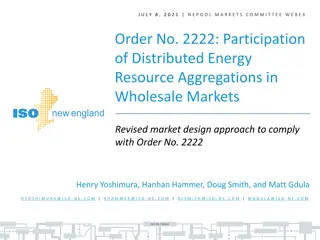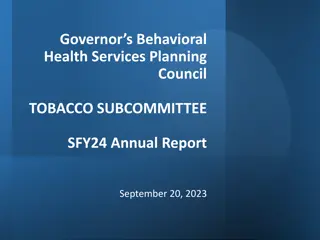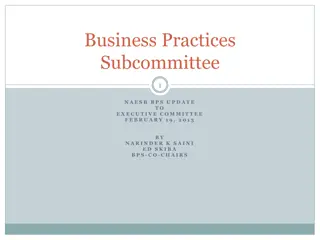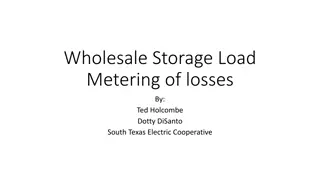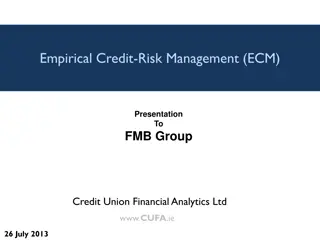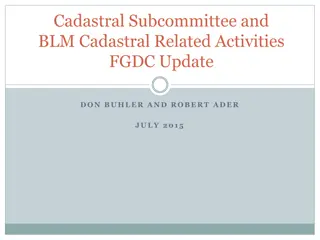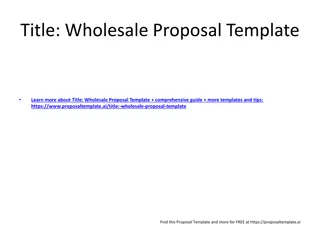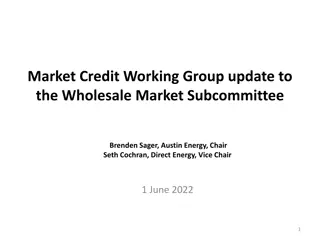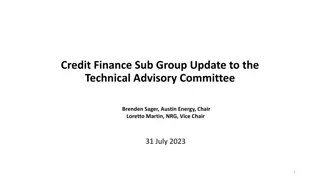Market Credit Working Group Update to Wholesale Market Subcommittee
The Market Credit Working Group provided updates to the Wholesale Market Subcommittee regarding NPRR review, focusing on NPRR 1088 which addresses credit impacts related to the elimination of RFAF and DFAF applications to prior and ongoing market positions. The discussion revolved around ERCOT credit staff concerns and the potential implications of reducing credit requirements. No immediate action is planned on NPRR 1088, with ongoing discussions on possible changes. Additionally, the document outlines ISO/RTO default allocation practices for various regions, detailing the basis and dissection of allocation assessments.
Download Presentation

Please find below an Image/Link to download the presentation.
The content on the website is provided AS IS for your information and personal use only. It may not be sold, licensed, or shared on other websites without obtaining consent from the author.If you encounter any issues during the download, it is possible that the publisher has removed the file from their server.
You are allowed to download the files provided on this website for personal or commercial use, subject to the condition that they are used lawfully. All files are the property of their respective owners.
The content on the website is provided AS IS for your information and personal use only. It may not be sold, licensed, or shared on other websites without obtaining consent from the author.
E N D
Presentation Transcript
Market Credit Working Group update to the Wholesale Market Subcommittee Brenden Sager, Austin Energy, Chair Seth Cochran, DC Energy, Vice Chair 2 June 2021 1
MCWG update to WMS General Update 18 Aug 2021 Joint MCWG/CWG WEBEX Meeting 1 NPRRs reviewed for their credit impacts, 1088 2
MCWG update to WMS Review NPRR 1088 Elimination of RFAF Elimination of Real-Time Forward Adjustment Factor (RFAF) and the Day-Ahead Forward Adjustment Factor (DFAF) from being applied to prior market positions and instead applies the RFAF and DFAF to ongoing market positions Currently, a short market position in June can cause credit to cap out in August, even if no market position is taken for the entire following month A Market Participant s estimated exposure should not fluctuate when they do not have a market position ERCOT credit staff not in favor of such changes as they will reduce credit requirements MCWG/CWG will continue to discuss possible changes. No action planned on this NPRR 3
ISO/RTO Default Allocation Practices ISO/RTO Default Allocation Practices ERCOT MISO SPP CAISO PJM Activity base used in default allocation: Based on previous month Max activity buckets: Based on invoice activity during the same period of time as the unpaid invoice(s) of the MP whose unpaid Past Due Amount has been declared an Uncollectible Obligation. Based on Invoice activity during the same period of time as the unpaid invoice(s) of the MP whose Unpaid Obligation has been declared an Uncollectible Obligation. Hybrid approach based on dollar and MW activity: Activity component is based on on last three months gross activity Based on quarterly percentage shares calculated based on quarterly average over rolling four- quarter look-back period: Default Allocation Assessment shall be equal to (0.1(1/N) + 0.9(A/Z)) -Metered -- Generation/DCT Imp -Metered Load -Bilateral sales -Bilateral purchases -DAM sales -DAM purchases -CRR Sales & ownership in DAM -CRR Auction Purchases The Uncollectible Obligation is allocated to all Non-Defaulting MPs who conducted business in the market during the time covered by the invoice(s) containing the Uncollectible Obligation(s). Allocated to each MP that had been invoiced during the same period of time as the unpaid invoice(s) of the MP whose unpaid Past Due Amount has been declared an Uncollectible Obligation. Dissection of calculation: 20% of payment default amount allocated in proportion to net amounts payable 1) % share to total number of participants weighted at 10% (not exceeding $10,000); and =% Loss for MPA = MPA Market Charges + Market Credits in weekly invoicing cycle/ MPALL (Market Charges + Market Credits) in weekly invoicing cycle. % Loss for MPA = MPA Market Charges + Market Credits in weekly invoicing cycle/MPALL (Market Charges + Market Credits) in weekly invoicing cycle 30% of payment default amount allocated in proportion to sum of absolute values of dollar amounts shown on invoices payable or receivable after certain dollar amount exclusions for GMC, RMR, and Wheeling Access Charge costs and exclusions for billing of Access Charges and payment of Transmission Revenue Requirements to Participating Transmission Owners 2) % share to total market over last 3 months weighted at 90% A = for Members comprising factor "N" above, the Member's gross activity as determined by summing the absolute values of the charges and credits for each of the Activity Line Items identified in section 15.2.2(b) below as accounted for and billed pursuant to Operating Agreement, Schedule 1, section 3 for the month of default and the two previous months. -Loss Obligation of MPA = ((% Loss for MPA) x $ Amt of Uncollectible Obligation) minus (- ) (Reduction of Payments + Pro rata share of partial payment(s)) Loss Obligation of MPA = (% Loss for MPA) x $ Amt of Uncollectible Obligation, where: MP = Market Participant -Market Charges = The absolute value of all charge amounts associated with invoices for Market Activities. -Market Credits = The absolute value of all credit amounts associated with invoices for Market Activities. -MPALL = All Market Participants other than MPs with Uncollectible Obligations. Where: -MP = Market Participant --Market Charges = The absolute value of all charge amounts associated with invoices for Market Services. -Market Credits = The absolute value of all credit amounts associated with invoices for Market Services. -MPALL = All Market Participants other than MPs with Uncollectible Obligations. -Reduction of Payment = The amount of the Unpaid Obligation originally assessed to MP -Pro rata share of partial payment(s) = Any partial payments received during cure period Z = the sum of factor A for all Members excluding ex officio Members, State Consumer Advocates , Emergency and Economic Load Response Program Special Members , and municipal electric system Members that have been granted a waiver under Operating Agreement, section 17.2. 50% of payment default amount allocated in proportion to largest of the following amounts calculated in MWh for every month in each applicable calendar quarter Cleared DA Schedules to supply Energy Metered Generation Cleared DA Schedules for demand Metered Load x 103%... The greater of the quantity of CRRs or Inter-SC Trades of Energy Default Uplift Billing Timeline no earlier than 90 days no prescribed timeline next practicable invoices
All ISO Credit Exposure Methods DC Energy supports the PJM model and will present later why they think it works better than the ERCOT model Growth in value from settlement invoices as opposed to MW value Goal: to spread risk across all the market to make a risk pool that makes sense Smooth out settlement bumps PJM is time-tested, worked through Greenhat (large default) and it s still standing The core of the methodology is gross value invoices, MISO, SPP, PJM 5
MCWG update to WMS Market-wide average TPE increased from $ 610.6 million in June to $ 704.3 million in July TPE increased mainly due to higher Forward Adjustment Factors in July compared to June Discretionary Collateral is defined as Secured Collateral in excess of TPE,CRR Locked ACL and DAM Exposure Average Discretionary Collateral increased from $1,791.3 million to $2,081.8 million The increase in Discretionary Collateral is largely due to increase in Secured Collateral. Short pay entities are excluded from the above calculations to remove data skew No unusual collateral call activity 6




